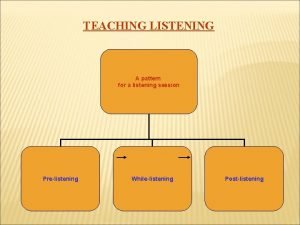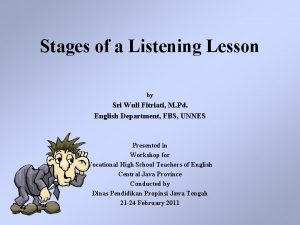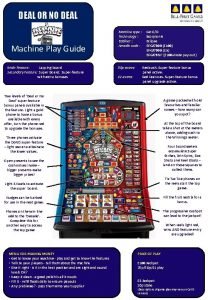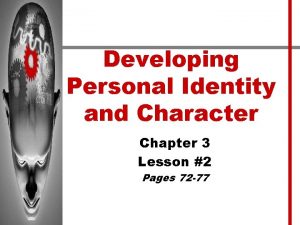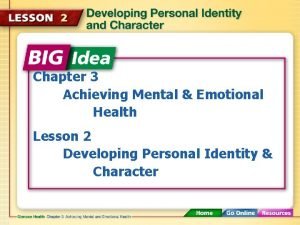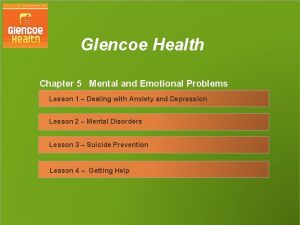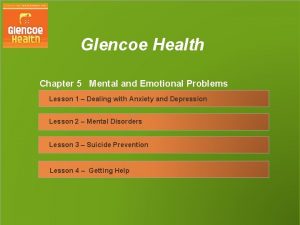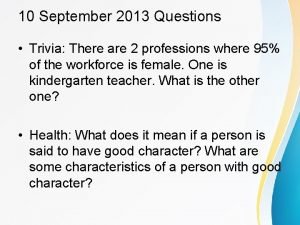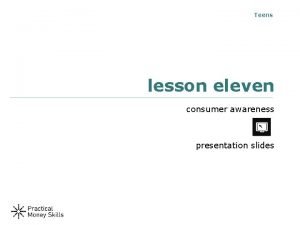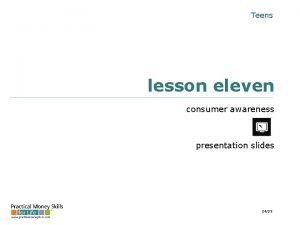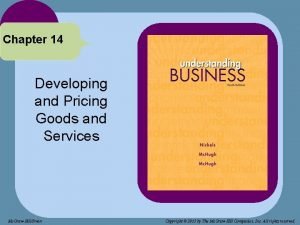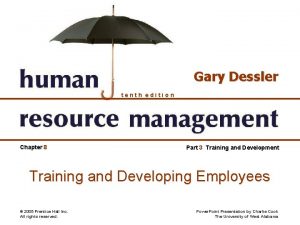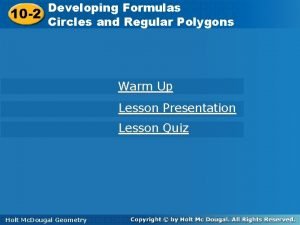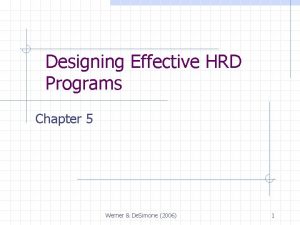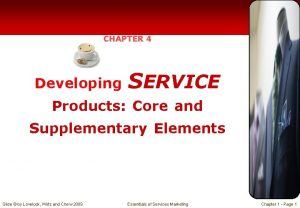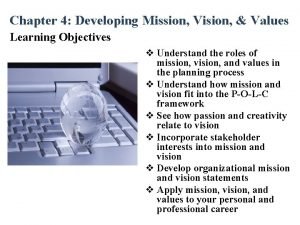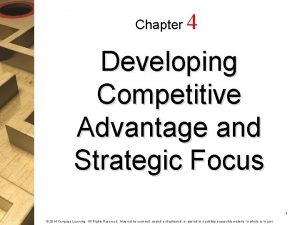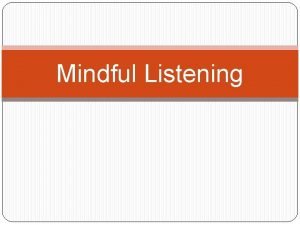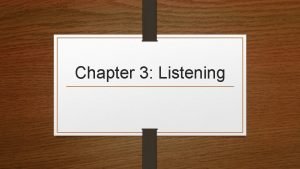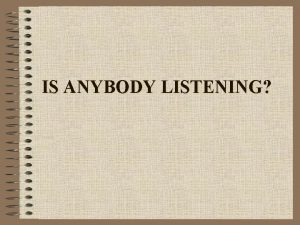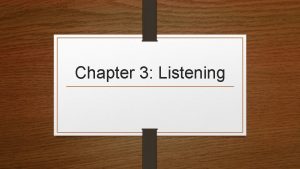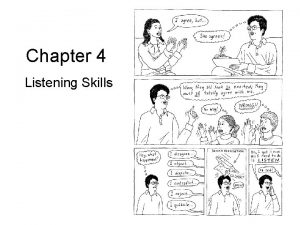Developing Emotional Awareness and Listening DEAL Lesson 2








































- Slides: 40

Developing Emotional Awareness and Listening (DEAL) Lesson 2 Y 10/11

Ground rules ● We will be open and honest, but not discuss directly our own or others’ personal lives. No names. ● We will keep the conversation within the room. ● It is okay for us to disagree with another person’s point of view but we will not judge anyone, make fun of anyone, or put anyone down. ● We have the right to pass. ● We will listen to the other person’s point of view and expect to be listened to. ● We will use the correct terms for the things we will be discussing. ● We know that no question is a stupid question. ● If we need further help or advice, we know how and where to seek it confidentially, both in school and in the community. We will encourage friends to seek help if we think they need it.

Success Criteria I can recognise that everyone experiences busy and pressurised times in their life I understand that a degree of pressure can be positive I know what happens to my body physically when I feel pressurised or stressed I can identify my core values in life, my triggers and I am developing a greater self awareness ● I have a range of strategies to help me during pressurised times ● ●

Types of pressure Going on holiday Poor health New part-time job Exams Friendship issues Applying for college Sports comp or drama performance ● Moving house ● New relationship ● Parents separating ● ● ● ● Create a table with columns labelled positive and negative pressure Sort the bullet points into the two columns (this may be different for each person) Think of four more pressures that young people face and sort these into the columns too.

Types of pressure Positive Negative

Pressure and performance Discuss the graph. Some pressure is a good motivator, it makes us feel invigorated. We have all experienced that feeling of being slightly outside our comfort zone and the thrill when we have accomplished something.

Pressure = Physical reaction

Pressure - signs and symptoms What you might be thinking. . . ● ● ● ● irritable, aggressive, impatient or wound up overburdened anxious, worried, nervous or afraid negative thoughts unable to relax and enjoy yourself like you've lost your sense of humour alone/lonely

Pressure - signs and symptoms How you might be feeling. . . ● ● ● shallow breathing muscle tension blurred eyesight, sore eyes or headaches problems getting to sleep, staying asleep and/or tired grinding your teeth or clenching your jaw Stomach upsets, feeling sick or dizzy

Pressure - signs and symptoms What you might be doing. . . ● ● ● ● finding it hard to make decisions worrying, restless and/or unable to concentrate avoiding situations that are troubling you snapping at people biting your nails eating too much or too little (or the wrong food) crying

Pressure - being self aware Be aware of how you are thinking, what you are feeling and doing in times of comfort and then how this changes during times of stretch, strain, or being overwhelmed This will allow you to take early action to reduce pressure

Class activity Scenario: You are moving out of area to a new home Discuss the three areas and make suggestions about what could go into each section

Changes in life With any personal issues, focus on the areas you can control or have influence over Find a mantra or quote that frames these feelings in a positive way. . .

Becoming self-aware - what is important? Activity - personal values cards Spread out the values cards and read them all through. Choose the 10 cards which best describe the very important values for you personally. Record these in your table. This is an individual activity and will not be shared, you will keep these for your emotional first aid boxes which we look at later. Your values are useful to help you identify your pressure triggers and priorities

My personal values Becoming self-aware - what is important? Value Description

Identifying your triggers Working out what triggers excessive pressure for you can help you anticipate problems and think of ways to solve them. Even if you can't avoid these situations, being prepared can help. You could consider: Issues that come up regularly, and that you worry about, for example your future (college and career) or volatile friendships One-off events that are on your mind a lot, such as moving house, mock exams or the loss of a pet Ongoing stressful events, like being a carer, worrying about your health (or the health of others), living between two homes, finances and money worries in the family

My triggers - complete on your own A regular issue that causes me stress A recent one off event that was difficult An ongoing concern that is on my mind Remember that not having enough work, activities or change in your life can be just as stressful a situation as having too much to deal with. Issues that conflict with the personal values you hold dear to you will be more significant triggers.

Self-care actions We will now look at what steps you should take when feeling under pressure 1. 2. 3. 4. 5. 5 ways to wellbeing (recap) Personal strengths/experiences Positive reframing Emotional first aid kit Organising your time

1. The five ways to wellbeing From DEAL session 1 we looked at these five areas. When you notice the pressure signs, symptoms and triggers… Check you have a good balance of these five in your life

Checking the five areas - spider diagram From the centre there are five levels of strength Plot your ‘score’ on each ray (the better you are, the further out you put your point) Connect Learn Activity Action: to cope better with pressure, ensure you have all five areas covered Notice Give

Checking the five areas - spider diagram Connect Complete your own spider diagram Learn Activity Notice Give

2. Draw on your strengths, skills and experiences 1. Select three cards that describe your skills or strengths 2. Now choose three cards to recognise something positive in the person sitting next to you. ● Skill cards ● Strength cards ● How do you feel when you are able to say something positive about yourself? ● Was it easier to see something good in someone else? If so, why?

My strengths, skills and experiences Cards I chose Cards chosen for me A difficult experience that I overcame Eg Moving to a new school, starting a new club/activity, recovering from an injury

3. Positive reframing We can all get into a cycle of negative thinking. Watch these next two clips to help you break this pattern University swimmer Kally Fayhee

Defeat negative thinking

Reframing examples

Reframing exercise Negative statement Reframed positive statement 1. I am rubbish at everything, I am going to fail 2. I get left out of everything, people just don’t really like me. In pairs work on reframing the negative thoughts. Share some of the statements from the class

Positive thoughts - affirmations Find your affirmations. When you have some time, google ‘affirmations’ and find two or three that you like. Print and pin these up in your room

4. Create an emotional first aid kit On the handout, make a list of all the items you want to put in your kit box. The next slide will give you some prompts

emotional first aid kit - ideas for contents Hot drink sachets Colouring sheets and pens Favourite joke stress/fidget toys Hot water bottle or cool pack 5 ways to wellbeing Spider diagram Affirmations Photos of great memories Chocolate/sweets Tea lights or fairy Rubber band lights Book, poems, lyrics List of go-to people 10 personal values Music playlist to and numbers list change mood Breathing Pine cone, pebble, techniques Strengths, skills and shell Journal/diary Perfume, scented candle, essential oil experiences card

Example

5. Organise your time Making some adjustments to the way you organise your time could help you feel more in control of any tasks you're facing, and more able to handle pressure. 1. Identify your best time of day, and do the important tasks that need the most energy and concentration at that time. For example, you might be a morning person or an evening person. 2. Make a list of things you have to do. Arrange them in order of importance, and try to focus on the most urgent, but the important thing is getting started so maybe try an easy job first.

3. Set smaller and more achievable targets. When you’re under a lot of pressure it’s easy to set yourself large targets that are often unachievable. Setting smaller goals can make you feel in more control and you can see your achievements more easily. 4. Vary your activities. Balance interesting tasks with more mundane ones, and stressful tasks with those you find easier or can do more calmly. 5. Take breaks and take things slowly. It might be difficult to do this when you're stressed, but it can make you more productive. 6. Ask someone if they can help. You could ask a friend or family to help with some of your daily tasks so that you have more time to spend completing your tasks that are causing you to feel stressed.

Summary 1. Be conscious of what you are THINKING-FEELING-DOING Are you in the stretched, stressed or overwhelmed stage? 2. Write down the thought you are having, is there any real evidence that it is true. Remind yourself about positive reframing.

Summary 3. Do not repeat the negative loop or it will reinforce it. Use your affirmations or positive memories and experiences to replace the negative thoughts 4. Rubber bands are flexible and bounce back into shape, wear one to remind you that this is temporary and you are resilient and will bounce back

Summary 5. Look at your personal tiggers and values, be ready to recognise and take action 6. Distract yourself, use your emotional first aid kit and check you have all the ‘five ways’ active and balanced in your life.

Review - Success Criteria I can recognise that everyone experiences busy and pressurised times in their life I understand that a degree of pressure can be positive I know what happens to my body physically when I feel pressurised or stressed I can identify my core values in life, my triggers and I am developing a greater self awareness ● I have a range of strategies to help me during pressurised times ● ●

Signposting support You can access support at home, and both in school (e. g. through your form tutor, school, or school nurse) and out of school, through local and national organisations. There are lots of different ways that you can seek help from reputable organisations, including text -based support, digital chat support and online counselling, as well as face to face or via phone. Young Minds - www. youngminds. org. uk Childline - www. childline. org. uk Phone: 0800 1111 Samaritans - www. samaritans. org Phone: 116 123 Shout - a 24 -hour text service for someone experiencing a crisis and needing immediate help: 85258

Key messages about support ● Sometimes we might want to speak with a confidential anonymous service (helpline) other times with people that know us well. ● Sometimes we might need to tell more than one person or service to get the help or support we need. ● Nothing is too small or too awful that we can’t talk about it

Remember. . .
 Pre listening while-listening and post listening examples
Pre listening while-listening and post listening examples While listening stage
While listening stage Deal or no deal machine
Deal or no deal machine Rudolf vizental
Rudolf vizental Cvs privacy awareness and hipaa training answers
Cvs privacy awareness and hipaa training answers Active and passive listening
Active and passive listening Define critical listening
Define critical listening Developing personal identity and character
Developing personal identity and character Chapter 3 achieving mental and emotional health
Chapter 3 achieving mental and emotional health Chapter 5 lesson 4 getting help answer key
Chapter 5 lesson 4 getting help answer key Chapter 5 mental and emotional problems lesson 2 answer key
Chapter 5 mental and emotional problems lesson 2 answer key Glencoe health chapter 5
Glencoe health chapter 5 Glencoe health chapter 5
Glencoe health chapter 5 Chapter 3 achieving mental and emotional health
Chapter 3 achieving mental and emotional health Lesson 8 developing good character
Lesson 8 developing good character Action plan to improve listening skills
Action plan to improve listening skills Lesson 11 consumer awareness answer key
Lesson 11 consumer awareness answer key Lesson eleven quiz consumer awareness
Lesson eleven quiz consumer awareness Developing and pricing goods and services
Developing and pricing goods and services Aaa new deal
Aaa new deal Dust bowl migration map
Dust bowl migration map Bolman and deal 4 frames
Bolman and deal 4 frames What is the main idea of this cartoon?
What is the main idea of this cartoon? Teddy roosevelt and the square deal
Teddy roosevelt and the square deal Chapter 33 the great depression and the new deal
Chapter 33 the great depression and the new deal Pretest: developing an academic and career plan
Pretest: developing an academic and career plan Adolescent egocentrism
Adolescent egocentrism Centration
Centration Difference between developing and underdeveloped countries
Difference between developing and underdeveloped countries Chapter 8 training and developing employees
Chapter 8 training and developing employees Transnational crime and the developing world
Transnational crime and the developing world What is good character
What is good character Developing null and alternative hypothesis
Developing null and alternative hypothesis What is the difference between direct and indirect guidance
What is the difference between direct and indirect guidance 10-1 developing formulas for triangles and quadrilaterals
10-1 developing formulas for triangles and quadrilaterals 10-2 developing formulas for circles and regular polygons
10-2 developing formulas for circles and regular polygons Developing formulas for triangles and quadrilaterals
Developing formulas for triangles and quadrilaterals Designing effective hrd programs
Designing effective hrd programs Flower of service
Flower of service Developing mission vision and values
Developing mission vision and values Developing competitive advantage and strategic focus
Developing competitive advantage and strategic focus
